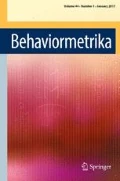Abstract
The growth curve model is useful for the analysis of longitudinal data. It helps investigate an overall pattern of change in repeated measurements over time and the effects of time-invariant explanatory variables on the temporal pattern. The traditional growth curve model assumes that the matrix of covariances between repeated measurements is unconstrained. This unconstrained covariance matrix often appears unattractive. In this paper, the generalized estimating equation method is adopted to estimate parameters of the growth curve model. As a result, the proposed method allows a more variety of constrained covariance structures than the traditional growth curve model. An empirical application is provided so as to illustrate the proposed method.
Similar content being viewed by others
References
Albert, J.M., & Kshirsagar, A.M. (1993). The reduced-rank growth curve model for discriminant analysis of longitudinal data. Australian Journal of Statistics, 35, 345–357.
Bagozzi, R.P., & Bergami, M. (2002). Antecedents and consequences of organizational identification and the nomological validity of the Bergami-Bagozzi scale. Paper submitted for publication.
Diggle, P.J. (1988). An approach to the analysis of repeated measurements. Biometrics, 44, 959–971.
Duncan, T.E., Duncan, S.C., Alpert, A., Hops, H., Stoolmiller, M., & Muthen, B. (1997). Latent variable modeling of longitudinal and multilevel substance use data. Multivariate Behavioral Research, 32, 275–318.
Duncan, T.E., Duncan, S.C., Hops, H., & Stoolmiller, M. (1995). An analysis of the relationship between parent and adolescent marijuana use via generalized estimating equation methodology. Multivariate Behavioral Research, 30, 317–339.
Grizzle, J.E., & Allen, D.M. (1969). Analysis of growth and dose response curves. Biometrics, 25, 357–381.
Guttman, L.A. (1954). A new approach to factor analysis: The radix. In P. F. Lazarsfeld (Ed.), Mathematical thinking in the social sciences (pp. 3–22). New York: Columbia University Press.
Hall, D.B., & Severini, T.A. (1998). Extended generalized estimating equations for clustered data. Journal of the American Statistical Association, 93, 1365–1375.
Joreskog, K.G. (1970). Estimation and testing of simplex models. British Journal of Mathematical and Statistical Psychology, 23, 121–145.
Khatri, C.G. (1966). A note on a MANOVA model applied to problems in growth curves. Annals of the Institute of Statistical Mathematics, 18, 75–86.
Laird, N.M., & Ware, J.H. (1982). Random-effects models for longitudinal data. Biometrics, 38, 963–974.
Liang, K.Y., & Zeger, S.L. (1986). Longitudinal data analysis using generalized linear models. Biometrika, 73, 13–22.
MacCallum, R.C., Kim, C., Malarkey, W.B., & Kiecolt-Glaser, J. K. (1997). Studying multivariate change using multilevel models and latent curve models. Multivariate Behavioral Research, 32, 215–253.
McCullagh, P. (1983). Quasi-likelihood functions. The Annals of Statistics, 11, 59–67.
McCullagh, P., & Nelder, J.A. (1989). Generalized linear models. London: Chapman & Hall.
Pan, W. (2001). Akaike’s information criterion in generalized estimating equations. Biometrics, 57, 120–125.
Poffhoff, R.F., & Roy, S.N. (1964). A generalized multivariate analysis of variance model useful especially for growth curve problems. Biometrika, 51, 313–326.
Ramsay, J.O. (in press). Multilevel modeling of longitudinal and functional data. To appear in D. Moskowitz & S. Hershberger (Eds.), Modeling intraindividual variability with repeated measures data: Methods and applications. New York: Erlbaum Associates.
Ramsay, J.O., & Silverman, B.W. (1997). Functional data analysis. New York: Springer Verlag.
Rao, C.R. (1965). The theory of least squares when the parameters are stochastic and its application to the analysis of growth curves. Biometrika, 52, 447–458.
Reinsel, G.C., & Velu, R.P. (1998). Multivariate reduced-rank regression: Theory and applications. New York: Springer Verlag.
Vonesh, E.F., & Carter, R.L. (1987). Efficient inference for random-coefficient growth curve models with unbalanced data. Biometrics, 43, 617–628.
Wedderburn, R.W.M. (1974). Quasi-likelihood functions, generalized linear models, and the Gauss-Newton method. Biometrika, 61, 439–447.
Zeger, S.L., & Liang, K.Y. (1986). The analysis of discrete and continuous longitudinal data. Biometrics, 42, 121–130.
Author information
Authors and Affiliations
Corresponding author
Additional information
The work reported in this paper was supported by Grant 290439 and Grant A6394 from the Natural Sciences and Engineering Research Council of Canada to the first and second authors, respectively. We thank Terry Duncan for his alcohol use data. The alcohol use data were made available by Grant DA09548 from the National Institute on Drug Abuse.
About this article
Cite this article
Hwang, H., Takane, Y. Estimation of Growth Curve Models with Structured Error Covariances by Generalized Estimating Equations. Behaviormetrika 32, 155–163 (2005). https://doi.org/10.2333/bhmk.32.155
Received:
Revised:
Published:
Issue Date:
DOI: https://doi.org/10.2333/bhmk.32.155




